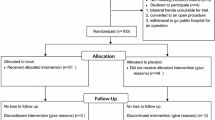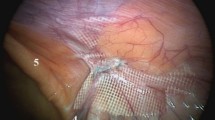Abstract
Purpose
To find the effect of pre-peritoneal instillation of bupivacaine on ‘dissectalgia’ (pain over a wide area corresponding to the area of pre-peritoneal dissection) and return to work following totally extraperitoneal (TEP) repair for groin hernia in labor-active males.
Methods
Fifty-three consecutive ASA grade I adult males undergoing TEP for groin hernia were randomized to control group A (n = 28) and test group B (n = 25), receiving 30 ml saline or 0.25% bupivacaine pre-peritoneally after placing mesh, respectively. Assessment parameters included time (h) to rescue analgesia, number of patients needing additional injectable analgesia at night during their hospital stay, visual analog scale (VAS) score for pain at 24 h, 48 h, and then weekly for 4 weeks, and time of resuming their job.
Results
The time to rescue analgesia was significantly shorter in group A (4.50 ± 2.3) than in group B (7.00 ± 4.1), P = 0.0077. A significantly greater number of group A patients needed additional injectable analgesia at bed time than group B patients (24 vs. 6, respectively, P < 0.0001 on the first night; 11 vs. 2, respectively, P = 0.008 on the second night). The VAS scores were significantly higher in group A patients than group B patients (3.47 ± 1.04 vs. 1.69 ± 1.04, respectively, at 24 h postoperatively, P < 0.0001; 2.29 ± 1.44 vs. 1.36 ± 0.81, respectively, at 48 h postoperatively, P = 0.0063). However, subsequent VAS scores up to 4 weeks postoperatively were comparable, as was the time of resuming their job. No patient had seroma/fluid collection, chronic pain, or recurrence, with the minimum follow-up being 3 years.
Conclusions
Dissectalgia following TEP deserves its due recognition. Pre-peritoneal bupivacaine instillation significantly reduces its occurrence, although the time of patient’s resuming their jobs remains unaffected.
Similar content being viewed by others
References
Memon MA, Cooper NJ, Memon B, Memon MI, Abrams KR (2003) Meta-analysis of randomized clinical trials comparing open and laparoscopic inguinal hernia repair. Br J Surg 90:1479–1492
Deans GT, Wilson MS, Brough WA (1998) Controlled trial of preperitoneal local anaesthetic for reducing pain following laparoscopic hernia repair. Br J Surg 85:1013–1014
Saff GN, Marks RA, Kuroda M, Rozan JP, Hertz R (1998) Analgesic effect of bupivacaine on extraperitoneal laparoscopic hernia repair. Anesth Analg 87:377–381
Schneider BE, Castillo JM, Villegas L, Scott DJ, Jones DB (2003) Laparoscopic totally extraperitoneal versus Lichtenstein herniorrhaphy: cost comparison at teaching hospitals. Surg Laparosc Endosc Percutan Tech 13:261–267
Heikkinen TJ, Haukipuro K, Koivukangas P, Hulkko A (1998) A prospective randomized outcome and cost comparison of totally extraperitoneal endoscopic hernioplasty versus Lichtenstein hernia operation among employed patients. Surg Laparosc Endosc 8:338–344
Kumar S (2009) A new balloon dissector for totally extraperitoeneal hernia repair. J Minim Access Surg 5:22–24
Wake BL, McCormack K, Fraser C, Vale L, Perez J, Grant AM (2005) Transabdominal pre-peritoneal (TAPP) vs totally extraperitoneal (TEP) laparoscopic techniques for inguinal hernia repair. Cochrane Database Syst Rev 25(1):CD004703. doi:10.1002/14651858.CD004703.pub2
O’Riordain DS, Kelly P, Horgan PG, Keane FB, Tanner WA (1998) A randomized controlled trial of extraperitoneal bupivacaine analgesia in laparoscopic hernia repair. Am J Surg 176:254–257
Hon SF, Poon CM, Leong HT, Tang YC (2009) Pre-emptive infiltration of Bupivacaine in laparoscopic total extraperitoneal hernioplasty: a randomized controlled trial. Hernia 13:53–56
Author information
Authors and Affiliations
Corresponding author
Rights and permissions
About this article
Cite this article
Kumar, S., Joshi, M. & Chaudhary, S. ‘Dissectalgia’ following TEP, a new entity: its recognition and treatment. Results of a prospective randomized controlled trial. Hernia 13, 591–596 (2009). https://doi.org/10.1007/s10029-009-0538-6
Received:
Accepted:
Published:
Issue Date:
DOI: https://doi.org/10.1007/s10029-009-0538-6




